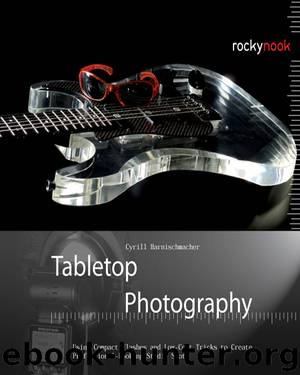Tabletop Photography by Cyrill Harnischmacher

Author:Cyrill Harnischmacher
Language: eng
Format: epub
Publisher: Rocky Nook Inc.
Published: 2012-06-13T16:00:00+00:00
Capturing the right moment is the big challenge of high-speed photography.
Long Exposures and Flash
Even in tabletop photography, there are occasions when it is desirable to include ambient sources of light. Consider situations when you need to photograph self-illuminating objects, such as computer monitors, cell phone screens, the illuminated controls of audio equipment, or candlelight. In normal studio exposures, these weak sources of light would be overpowered by the strength of the flash. There is a relatively simple solution to this problem: combining a shot with a long exposure time and a shot with flash. You can even accomplish this in one exposure without using picture editing software on a computer. You just need to take a couple of precautions.
The most important requirement is a tripod for your camera. Ideally you should be able to release your camera’s shutter remotely to avoid camera shake. If you don’t have a remote trigger, you can also use your camera’s self-timer feature. While the self-timer is counting down, it gives the camera and lens a few seconds to steady themselves, which increases your chances for a focused exposure.
Using the settings for the flash exposure, take a few test shots. If the overall lighting suits your needs, then darken the room as much as possible and program your camera for a slower shutter speed. The length of the exposure depends on the luminosity of the various elements in your scene, but it can extend upward of several seconds.
Now you can get started with your actual shots. Switch the camera to manual mode and select the shutter speed that you determined for the long-exposure shot. Now the flash units will establish the prevailing lighting conditions at the front end of the exposure window, but nearly the only light that will reach the camera’s sensor for the rest of the exposure time is the light from the self-illuminating object. If you choose a small aperture and a long exposure time, you can also manually fire the flash at some point during the exposure.
Furthermore, you can create interesting effects by using a flash unit set to a low output multiple times during a single exposure from different locations and with different color gels. Experiments such as this are nearly impossible with large studio flash systems. In this case, shoe-mount flashes have the clear upper hand, thanks to their modest size.
Download
This site does not store any files on its server. We only index and link to content provided by other sites. Please contact the content providers to delete copyright contents if any and email us, we'll remove relevant links or contents immediately.
Shoot Sexy by Ryan Armbrust(17659)
Portrait Mastery in Black & White: Learn the Signature Style of a Legendary Photographer by Tim Kelly(16954)
Adobe Camera Raw For Digital Photographers Only by Rob Sheppard(16906)
Photographically Speaking: A Deeper Look at Creating Stronger Images (Eva Spring's Library) by David duChemin(16623)
Bombshells: Glamour Girls of a Lifetime by Sullivan Steve(13977)
Art Nude Photography Explained: How to Photograph and Understand Great Art Nude Images by Simon Walden(12975)
Perfect Rhythm by Jae(5326)
Pillow Thoughts by Courtney Peppernell(4211)
The Book of Joy by Dalai Lama(3903)
Good by S. Walden(3489)
The Pixar Touch by David A. Price(3366)
A Dictionary of Sociology by Unknown(3031)
Fantastic Beasts: The Crimes of Grindelwald by J. K. Rowling(2995)
Humans of New York by Brandon Stanton(2835)
Stacked Decks by The Rotenberg Collection(2812)
Read This If You Want to Take Great Photographs by Carroll Henry(2664)
On Photography by Susan Sontag(2576)
Insomniac City by Bill Hayes(2499)
Photographic Guide to the Birds of Indonesia by Strange Morten;(2490)
